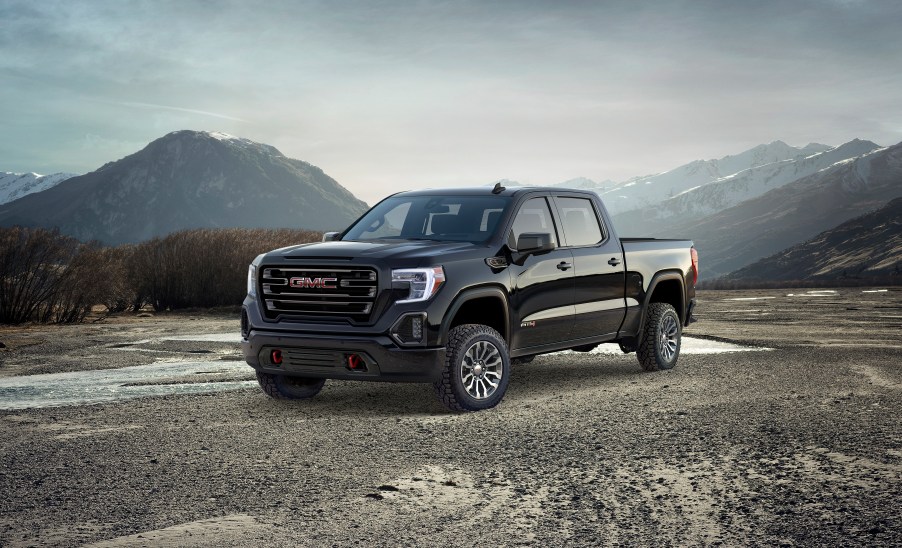
2020 GMC Sierra 1500 Diesel Drives Like a Normal Truck
Recently, we learned that the 2020 GMC Sierra 1500 diesel had earned an EPA rating of 23/30/26 mpg (city/highway/combined). Granted, that figure drops a bit if you choose the 4×4 version, but still. It seems like only yesterday that we were cheering midsize pickup trucks for finally cresting 30 mpg highway. The fact that a full-size pickup truck is already just as efficient is genuinely impressive.
Compare the 2020 Sierra 1500 diesel to the 2010 lineup, and that 30-mpg-highway figure stands out even more. Back then, the most fuel-efficient Sierra 1500 you could buy was the short-lived hybrid model that was rated at a mere 22 mpg highway. Heck, the 2.4-liter version of the 2010 Toyota Corolla is slightly less fuel-efficient than the 2020 Sierra 1500 diesel. A decade sure does make a difference.
Diesel Power

If you though GMC might have sacrificed power to boost fuel economy, don’t worry. The 3.0-liter inline-six that the Sierra shares with the Chevrolet Colorado is paired with a 10-speed automatic and is good for 277 hp and 460 lb-ft of torque. More importantly, peak torque is available from 1,500 rpm. If you want grunt, this all-aluminum engine’s got it.
That said, if you need to tow more than 10,000 lbs, you’ll need to skip the diesel in favor of the 6.2-liter gasoline V8. The Sierra 1500 maxes out at 9,100 lbs, while its competitors at Ford and Ram can tow considerably more. If you don’t necessarily need to tow 12,000 lbs, though, it’s definitely worth taking a closer look at the GMC because whatever you decide to pull behind you, the Sierra 1500 tows it well.
The automatically applied parking brake, for example, means you don’t have to worry about the truck rolling back while you’re trying to hook up a trailer. And thanks to the 15-angle camera system, everything about hooking up, backing up, and driving becomes significantly easier.
Towing Experience

With 8,000 lbs in tow, the Sierra 1500 diesel ended up being surprisingly easy to drive. It’s not exactly quick, but it’s quick enough. There’s also enough torque to make steep grades a non-issue. Perhaps more importantly, the truck felt stable and predictable, even on winding mountain roads. It’s always important to stay alert while towing, but it was nice to not feel like we were constantly fighting to keep the trailer under control.
Traditionally, opting for the diesel engine meant you were forced to put up with a louder, more rattly engine in exchange for better fuel economy and a mountain of torque. For perhaps the first time ever, though, that’s not the case. Unless you count the Silverado 1500 with the same engine. Not only is it smooth and quiet, but we’d also be willing to bet most passengers would have no idea they were in a diesel truck. Heck, most drivers probably wouldn’t realize it either unless you told them.
AT4 or Denali?

You’ll be able to add the diesel engine to several different versions of the Sierra 1500, but if we had to pick our money would probably go towards the AT4. You won’t be chasing down Ford F-150 Raptors in the Sierra 1500 AT4, but as we experienced in the off-road portion of our drive, the AT4 can still splash through mud and crawl up rocks pretty darn well. That’s partly due to the AT4 package coming with a 2.0-inch factory lift and all-terrain tires, but the two-speed transfer case, locking rear differential, and off-road shocks certainly helped.
From an aesthetic point of view, we also prefer the AT4’s dark, chrome-free exterior to the Denali, despite the Denali name having more prestige. And while the Denali is a bit more luxurious, the Sierra AT4 didn’t feel like as big of a step down as we expected. It’s not like the Denali is uncomfortable or feels cheap. We’d just prefer to see GMC bump up the base price another $5,000 or so and add higher quality, more luxurious materials to take on the high-end versions of the new Ram. Then again, there’s a reason journalists rarely go on to become product planners.

Overall, though, we came away impressed with the Sierra’s new diesel engine. For the same price as a 6.2-liter V8 Sierra, you get better fuel economy but don’t have to sacrifice much in terms of towing capacity or refinement. At least for now, we’ll call that a win.


